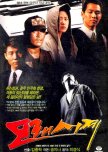Marking The Milestones In History
In the scenes of military violence towards peaceful Gwangju citizens, people who are being brutally beaten do not scream. They're filmed dancing. These disoriented civilians are waltzing to the dizzy dance of panic and agony. The drama Sandglass is uniquely lyrical in its approach to cinematography. With chunky old cameras and 4:3 aspect ratio, it seamlessly exercises dramatic hard shadows, Dutch angles, daring close-ups, insertions of archival footage, camera circling around the characters, overall rather bold moves for an old TV production. But it's only one of its merits. Stay with me here.
"Remember what they teach you at school? Our country is a democratic state and belongs to our people. But such illiterate people like me can't even protect themselves."
🔸Why was it named Sandglass? An hourglass is sometimes associated with impermanence of life and inevitability of death. The drama does talk about death and fate, particularly in the perspective of the people who remained alive. It talks about the survivors, the witnesses, the participants of one terrible period in South Korean history - the authoritarian rule and the Gwangju Uprising of 1980 - and their collective trauma. While the bloody suppression of the uprising is one of the focal points that changes the life of the main character Woo Seok, who was ordered as a soldier to shoot at civilians, it only acts as an attempt to release the tension between the regular citizens and the controlling state. The plot of the drama describes the continuing struggles of the main characters with the dehumanizing government institutions - the indoctrinating concentration camp that Tae Soo had to go through (similar has remained in North Korea to this day), and torturing in jail that Hye Rin was subjected to for not naming other students in opposition. After witnessing all that terror, the lives of the characters could never remain the way they were before.
"그 다음은 문제야. 그 다음 어떻게 사는지 잊지 마라."
🔸The key success element of Sandglass, as I see it, was the perfect timing of its release. 1995 was an extraordinary year for South Korea full of political scandals exposing the structural corruption that had long flourished in the country. The year was marked with the unprecedented arrests of two former presidents: Noh Tae Woo, following the scandal about his giant slush fund, and Jeon Doo Hwan who was responsible for the violent suppression in Gwangju. It was the year of a significant leap in SK's transition to democracy, and, to move forward, historical reflection was needed. Addressing the old political issues helped the Korean society come to terms with its authoritarian past and move on.
South Koreans were eager for justice after the long decades of censorship and oppression, and Sandglass provided them with that unconditional justice. But the story is not a dream come true - its honesty is brutal. Justice comes for everyone in all forms, even for those characters you wish were left in peace at last. It comes for the mafia leader Lee Jeong Do, it comes for the corrupted officials, it comes for Hye Rin who lost her people to keep her father's casinos, and, finally, justice comes for Tae Soo who "had many chances to turn his life around but always chose the easy way". The ending of Sandglass is very grounding, and it encourages you to rethink your life choices you had the liberty to make. "It only matters what was after. Don't forget how you chose to live".
Sandglass processes the collective trauma in detail. However, it fails in tackling the trauma on a personal level. When Hye Rin was released out of prison she spends several days in her room in deep shock, not eating anything, not responding to anyone. But the next episode she is shown completely fine, and soon you forget that she was actually tortured in there. Another problem is the tedious filling episodes in the middle about the gangs and shady business that aren't emotionally impactful. What I also found weird is the Soviet song "Cranes" being most often played in the scenes with the criminals negotiating their business. The translation of that song tells how the souls of soldiers killed in WW2 fly away as white cranes. Putting the song on during those moments doesn't feel very appropriate. That's why, for me, Sandglass is far from perfection despite all of its brilliance in other parts.
The story of the drama gets even more dark if you take into account the tragic life of its director Kim Jong Hak. After the financial losses from his late projects he was placed under the investigation and commited suicide in 2013. In his honor, Sandglass was rerun on SBS Plus on its original broadcasting schedule - two episodes per night four days a week.
🔸So, in the end, why should you watch this old-time drama existing exclusively in low quality somewhere off streaming platforms?
Because young Lee Jung Jae is hot AF.
Or...
Because it will give you the idea of how vast the impact of politics can be, through the example from modern SK history, and how little control an individual can have of their own life. For those viewers interested in exploring historical Korean identify and shared suffering, often called "Han", it provides a unique lens into the struggles faced by past generations. In its times, the drama also challenged the taboo of criticizing the government and portraying the tragic and unsightly aspects of Korean history. All in all, watch it at least to see how K-dramas developed and what they looked like before.
"Remember what they teach you at school? Our country is a democratic state and belongs to our people. But such illiterate people like me can't even protect themselves."
🔸Why was it named Sandglass? An hourglass is sometimes associated with impermanence of life and inevitability of death. The drama does talk about death and fate, particularly in the perspective of the people who remained alive. It talks about the survivors, the witnesses, the participants of one terrible period in South Korean history - the authoritarian rule and the Gwangju Uprising of 1980 - and their collective trauma. While the bloody suppression of the uprising is one of the focal points that changes the life of the main character Woo Seok, who was ordered as a soldier to shoot at civilians, it only acts as an attempt to release the tension between the regular citizens and the controlling state. The plot of the drama describes the continuing struggles of the main characters with the dehumanizing government institutions - the indoctrinating concentration camp that Tae Soo had to go through (similar has remained in North Korea to this day), and torturing in jail that Hye Rin was subjected to for not naming other students in opposition. After witnessing all that terror, the lives of the characters could never remain the way they were before.
"그 다음은 문제야. 그 다음 어떻게 사는지 잊지 마라."
🔸The key success element of Sandglass, as I see it, was the perfect timing of its release. 1995 was an extraordinary year for South Korea full of political scandals exposing the structural corruption that had long flourished in the country. The year was marked with the unprecedented arrests of two former presidents: Noh Tae Woo, following the scandal about his giant slush fund, and Jeon Doo Hwan who was responsible for the violent suppression in Gwangju. It was the year of a significant leap in SK's transition to democracy, and, to move forward, historical reflection was needed. Addressing the old political issues helped the Korean society come to terms with its authoritarian past and move on.
South Koreans were eager for justice after the long decades of censorship and oppression, and Sandglass provided them with that unconditional justice. But the story is not a dream come true - its honesty is brutal. Justice comes for everyone in all forms, even for those characters you wish were left in peace at last. It comes for the mafia leader Lee Jeong Do, it comes for the corrupted officials, it comes for Hye Rin who lost her people to keep her father's casinos, and, finally, justice comes for Tae Soo who "had many chances to turn his life around but always chose the easy way". The ending of Sandglass is very grounding, and it encourages you to rethink your life choices you had the liberty to make. "It only matters what was after. Don't forget how you chose to live".
Sandglass processes the collective trauma in detail. However, it fails in tackling the trauma on a personal level. When Hye Rin was released out of prison she spends several days in her room in deep shock, not eating anything, not responding to anyone. But the next episode she is shown completely fine, and soon you forget that she was actually tortured in there. Another problem is the tedious filling episodes in the middle about the gangs and shady business that aren't emotionally impactful. What I also found weird is the Soviet song "Cranes" being most often played in the scenes with the criminals negotiating their business. The translation of that song tells how the souls of soldiers killed in WW2 fly away as white cranes. Putting the song on during those moments doesn't feel very appropriate. That's why, for me, Sandglass is far from perfection despite all of its brilliance in other parts.
The story of the drama gets even more dark if you take into account the tragic life of its director Kim Jong Hak. After the financial losses from his late projects he was placed under the investigation and commited suicide in 2013. In his honor, Sandglass was rerun on SBS Plus on its original broadcasting schedule - two episodes per night four days a week.
🔸So, in the end, why should you watch this old-time drama existing exclusively in low quality somewhere off streaming platforms?
Because young Lee Jung Jae is hot AF.
Or...
Because it will give you the idea of how vast the impact of politics can be, through the example from modern SK history, and how little control an individual can have of their own life. For those viewers interested in exploring historical Korean identify and shared suffering, often called "Han", it provides a unique lens into the struggles faced by past generations. In its times, the drama also challenged the taboo of criticizing the government and portraying the tragic and unsightly aspects of Korean history. All in all, watch it at least to see how K-dramas developed and what they looked like before.
Vond je deze recentie nuttig?


 1
1
















